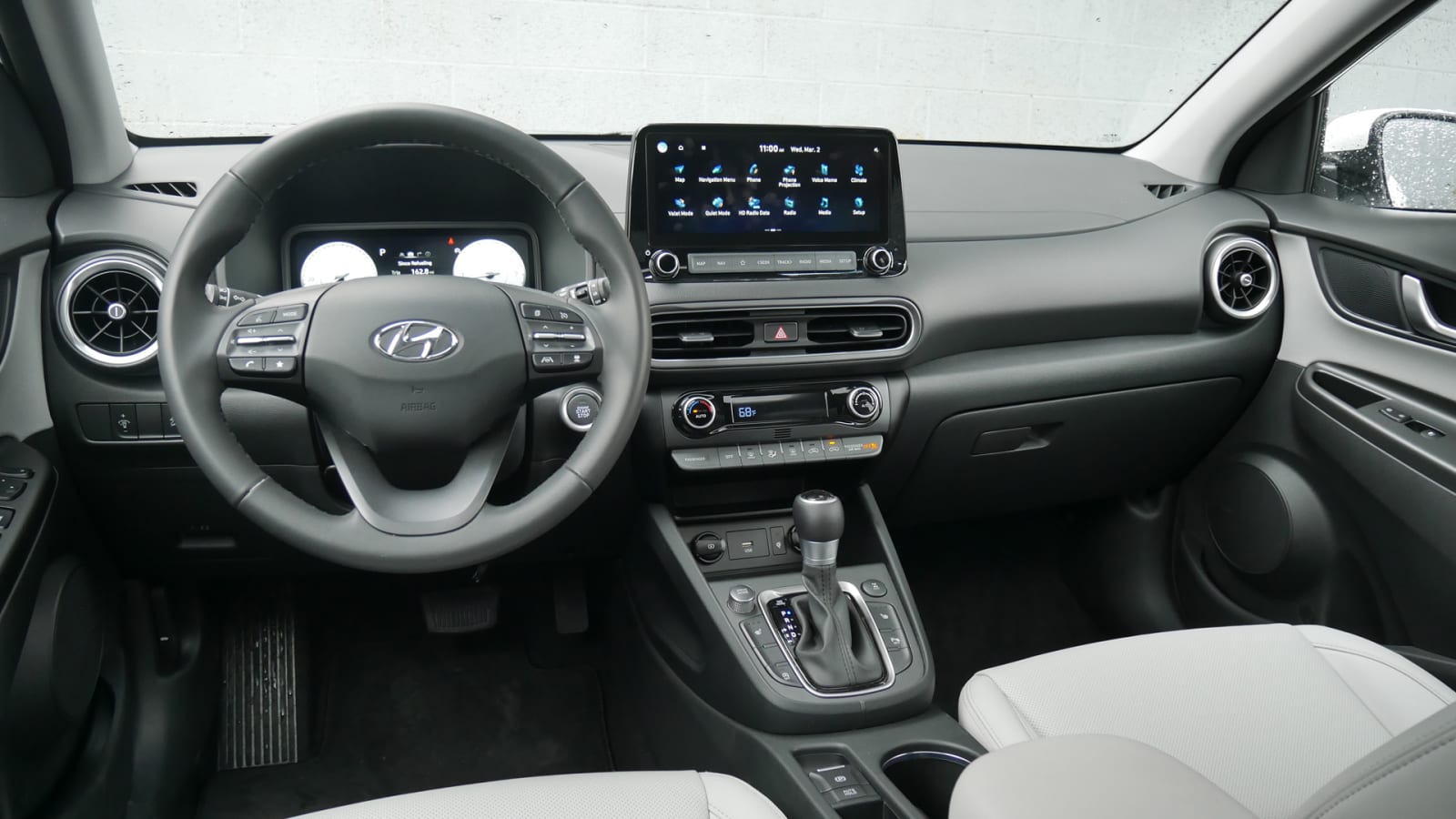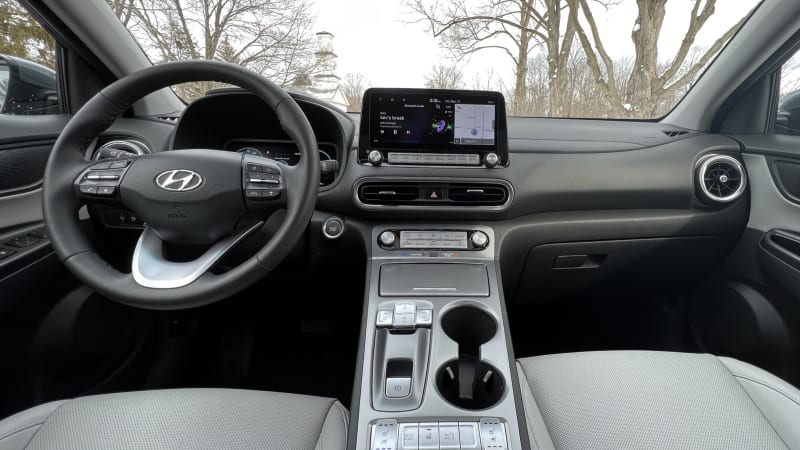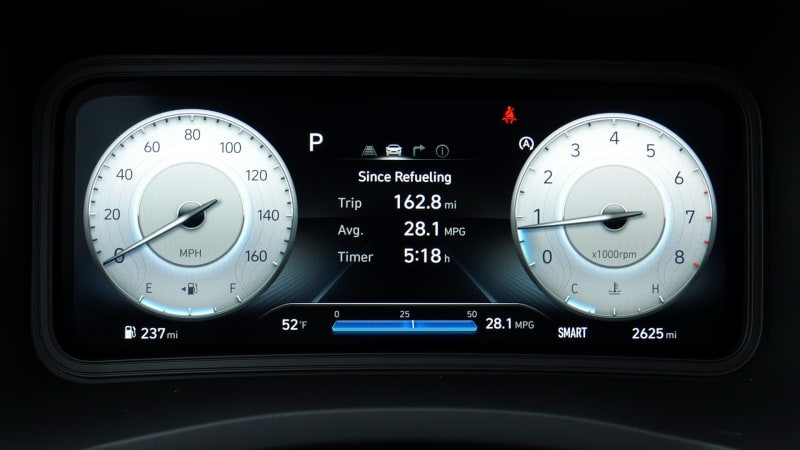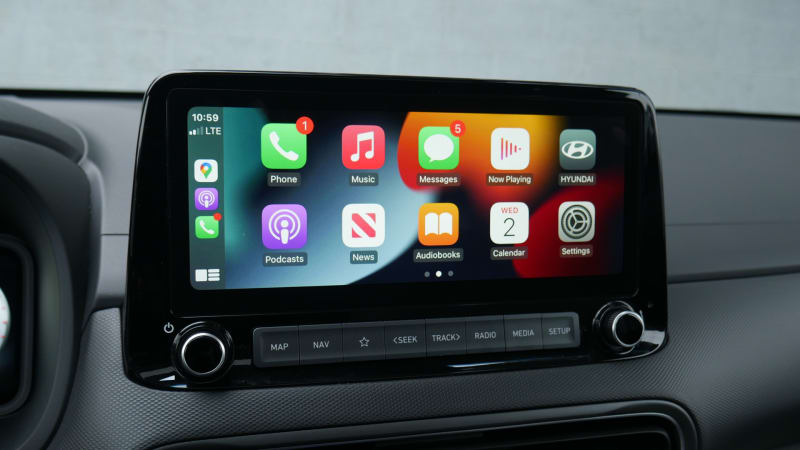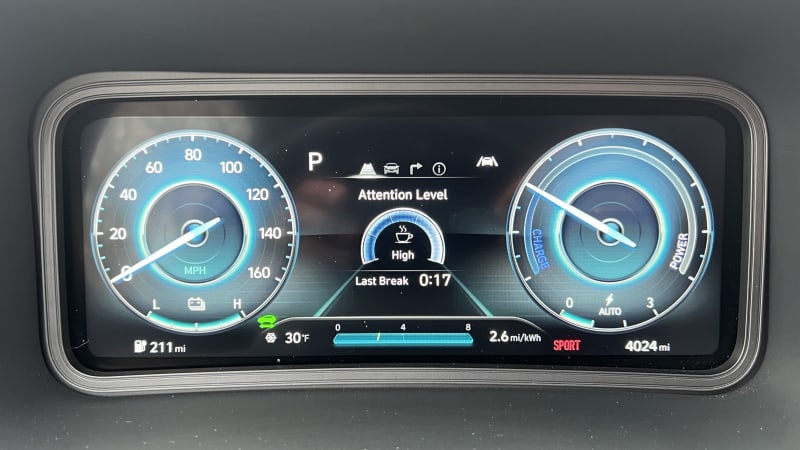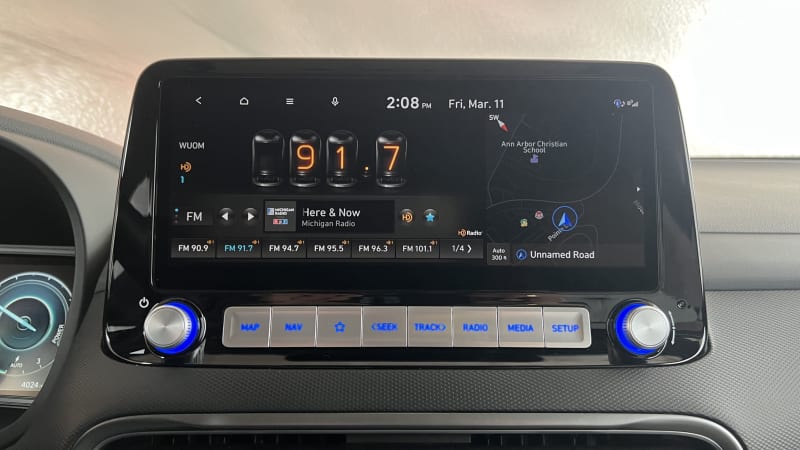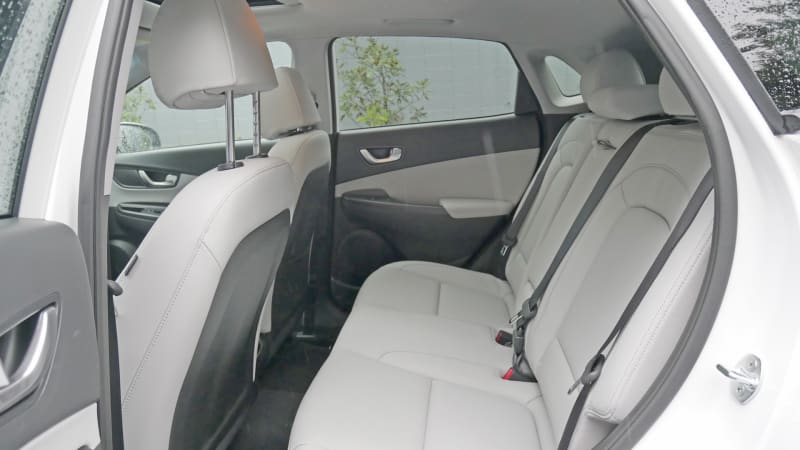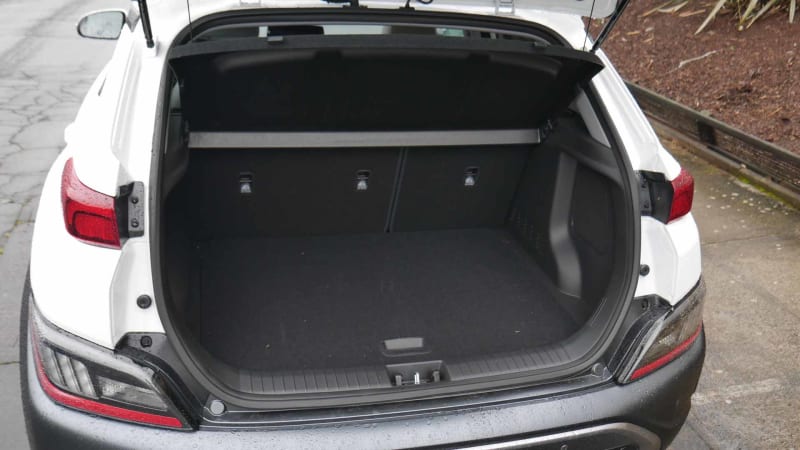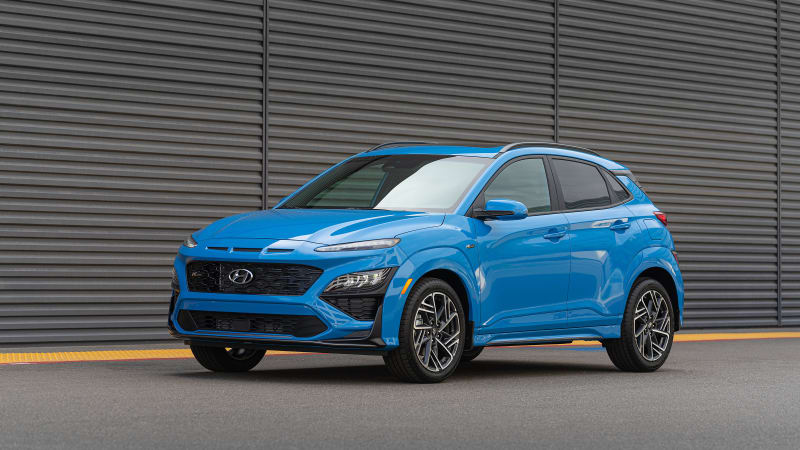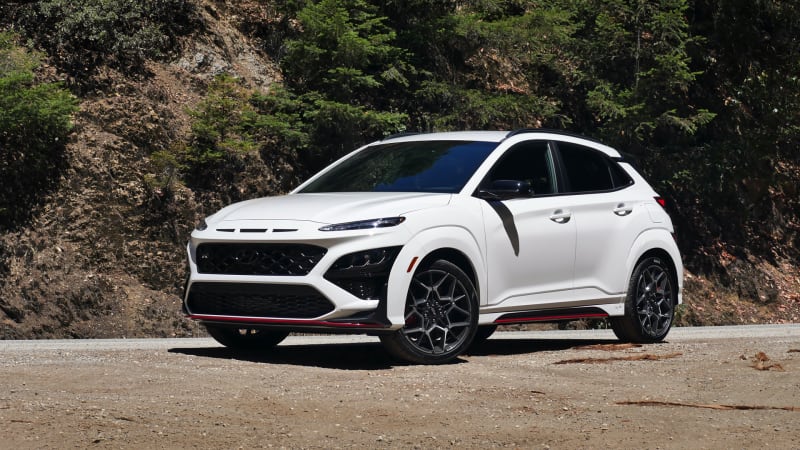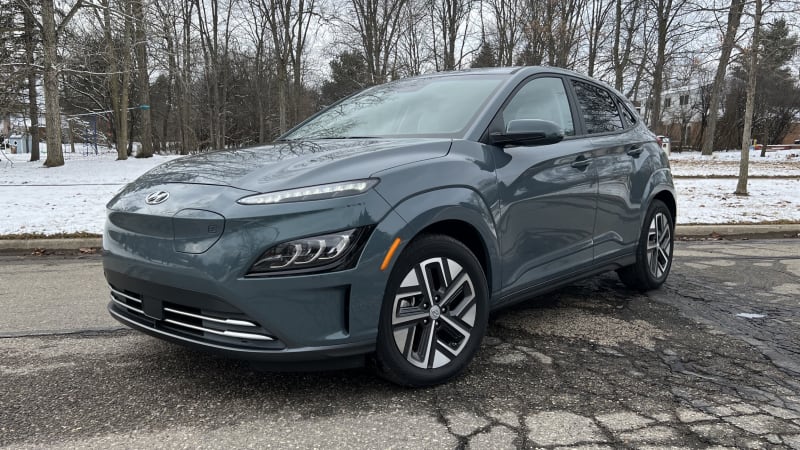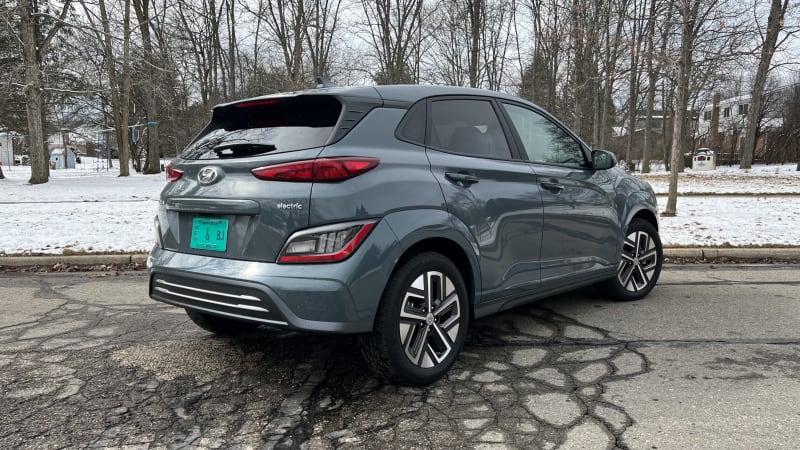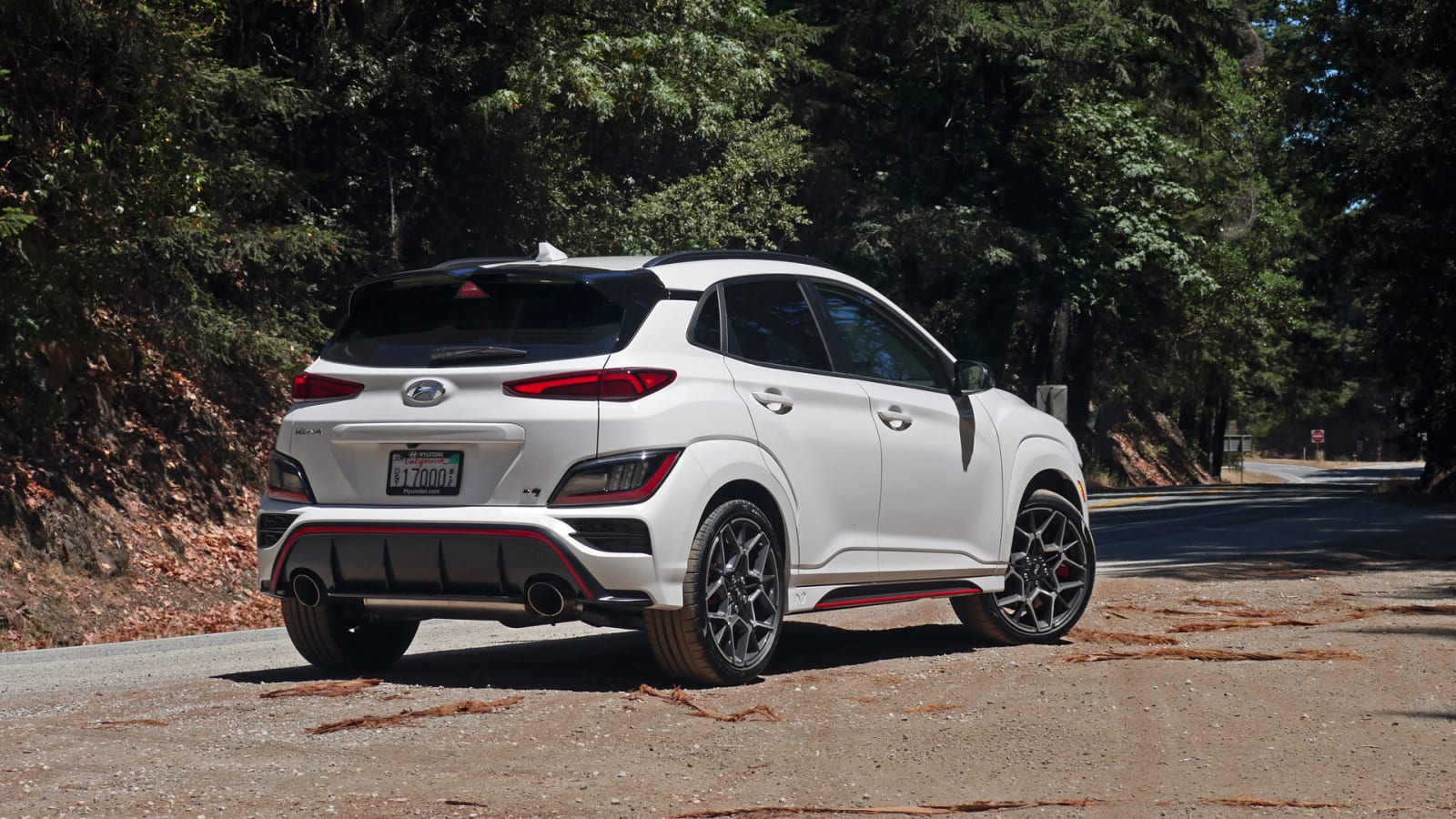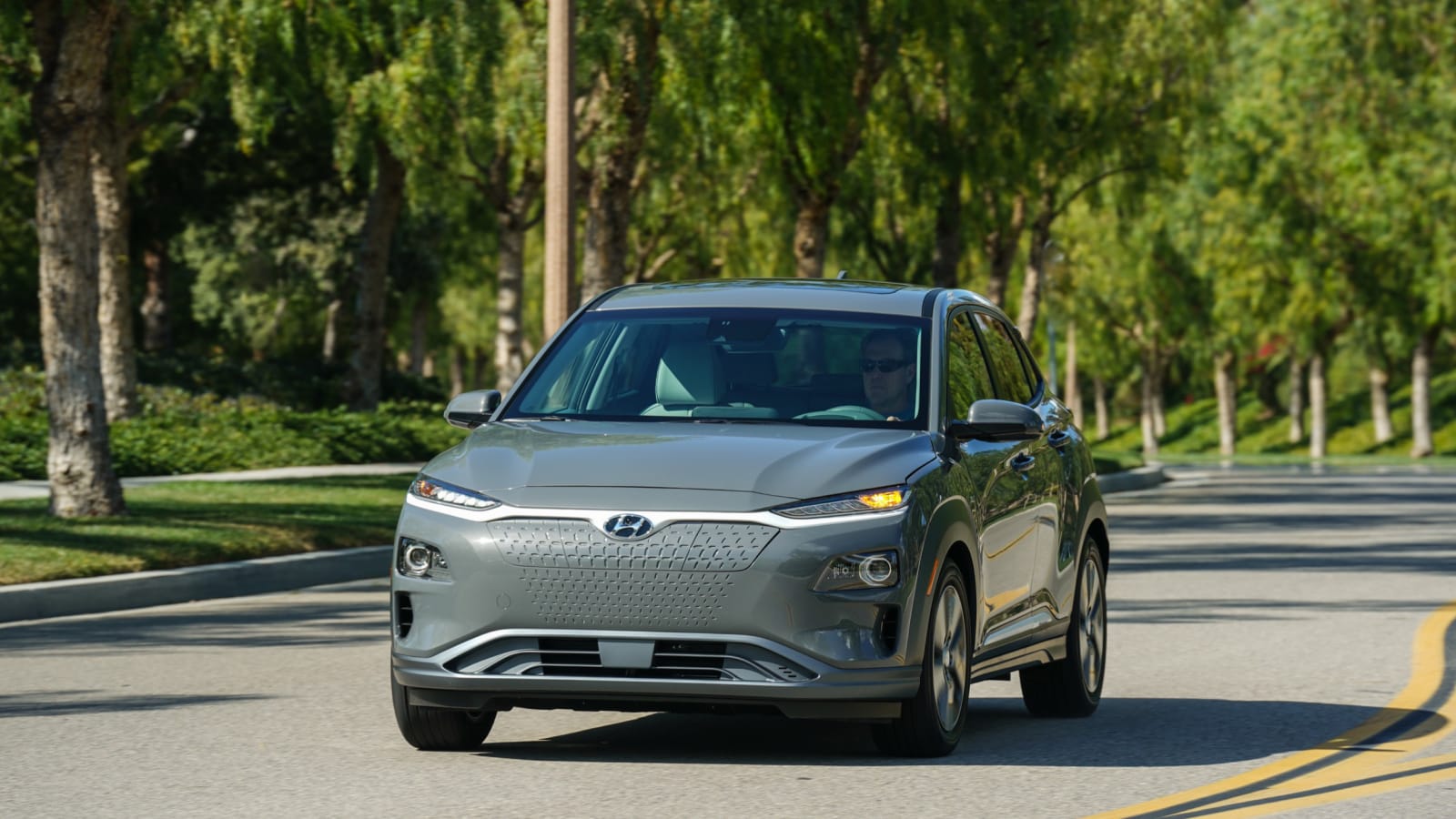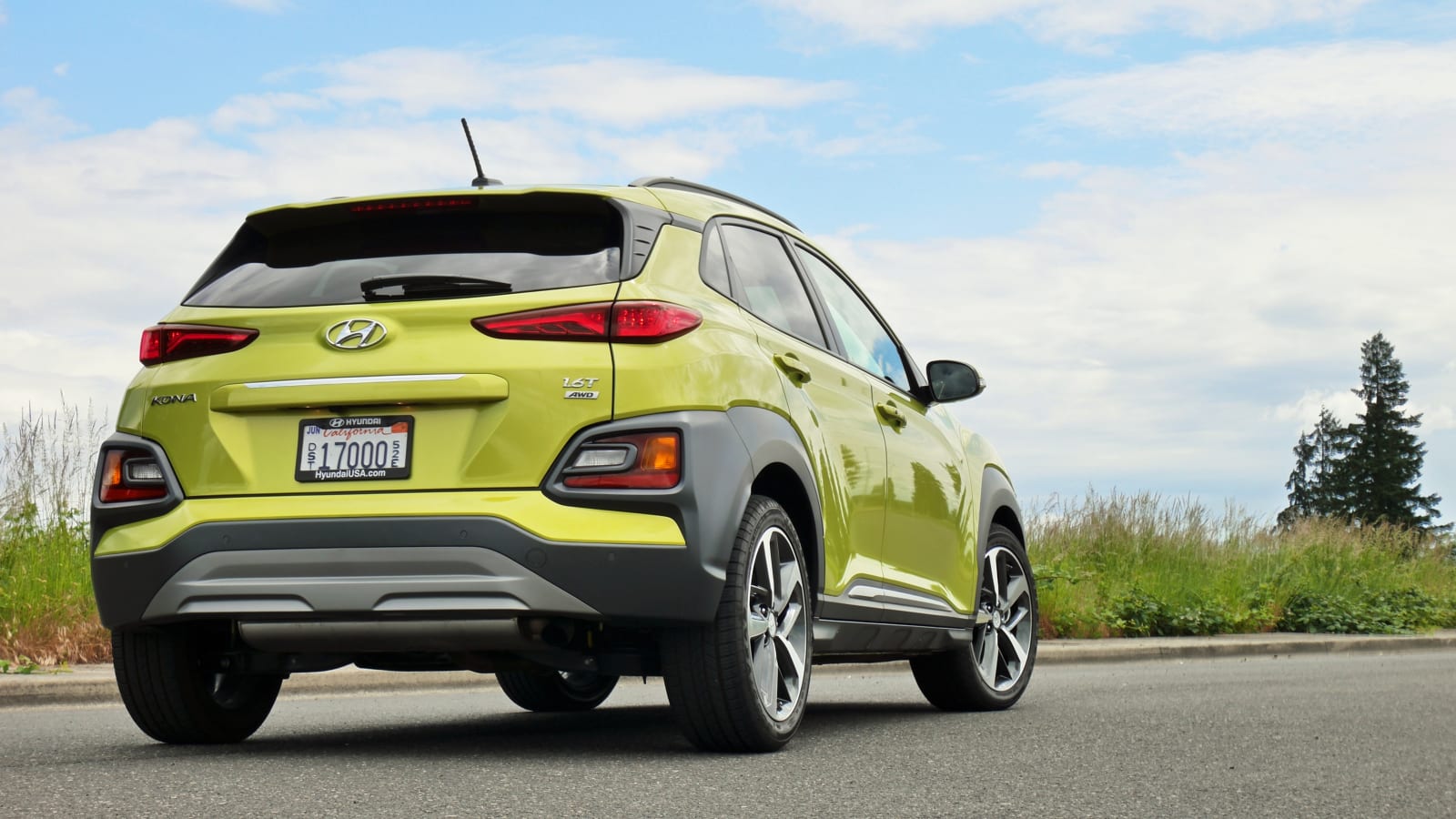This is really a review about three cars, maybe four. Although all fall under the umbrella of 2022 Hyundai Kona and all share a common, funky, subcompact SUV look, they are decidedly different in terms of their purpose and how they’re powered. For most buyers, “the Hyundai Kona” is a subcompact SUV with a modest engine, a modest price and a generous amount of equipment and warranty coverage. It stands out from the crowd with its distinctive styling, user-friendly tech and a driving experience that’s surprisingly fun (on the other hand, it’s also one of the least spacious in its segment). It’s one of our top-recommended subcompact SUVs.
Then things get really interesting. As fun as the base Kona can be, there’s a 1.6-liter turbo engine upgrade available that ups power to a level that few rivals get close to approaching, let alone surpassing. It comes standard on the Limited, pictured above, as well as the new-for-2022 Kona N-Line, which really leans into the Kona’s sporty vibe. The also-new 2022 Kona N, meanwhile, not only leans into it, but fully immerses itself and rolls around in a joyous celebration of silly power, boisterous noise and hot hatch handling. It’s a riot.
And finally, there’s the 2022 Hyundai Kona Electric, which is one of your best bets among lower-priced EVs. It has an ample 258 miles of range, in part because it’s one of the most efficient EVs, and is similarly a joy to drive – just in a much quieter way. In other words, no matter which of the Kona flavors you consider, know that you’re looking at one of our favorites in its respective segment.
Interior & Technology | Passenger & Cargo Space | Performance & Fuel Economy
What it’s like to drive | Pricing & Features | Crash Ratings & Safety Features
What’s new for 2022?
The high-performance Kona N is introduced and it’s a hoot. Think of it as a kinda-tall hot hatch. The also-new Kona N Line isn’t nearly as hot, but it at least looks sportier than other trim levels that retain a more SUV-like look. The carry-over Kona models, including the Electric, get updated styling and a slightly different interior. For the latter, the outboard air vents are now round, the center console slightly disconnected from the dash above and, more notably, the 10.25-inch widescreen infotainment display found elsewhere in the Hyundai lineup is now available on top trim levels. Hyundai also says the cargo space and back seat legroom have increased, but only by a tiny amount. In terms of mechanical upgrades, the base engine is now paired with Hyundai’s “IVT” continuously variable transmission, while the suspension of non-N models is updated for sharper handling and a better ride.
What are the Kona interior and in-car technology like?
For the money and for this humble segment, the Kona interior is just fine. Plastics are unremarkable and the design is a bit blah, especially since Hyundai no longer offers vibrantly colored trim options or distinctive houndstooth standard upholstery. It’s all very monochromatic now. At least the Kona Electric (above right) spruces things up with a richer standard upholstery, light-colored leather and silver trim, plus a unique rising center console and push-button shifter. The new Kona N (above left) also gets nicer upholstery on sport seats plus a very cool sport steering wheel.
With either design, the low dash offers good visibility, the steering wheel sufficiently adjusts, and upper trims benefit from a power driver seat that provides more adjustability than most in the segment. The driving position is also higher than a car (which you definitely notice in the Kona N), but we wouldn’t say you get the “commanding view” of the road like you’d get in a bigger crossover.
One of the Kona’s major perks is the easy-to-use infotainment system, which is augmented for 2022 with the availability of Hyundai’s best 10.25-inch widescreen display. With that or the standard 8-inch touchscreen, a user-friendly interface pairs with plenty of physical shortcut buttons, and importantly, physical volume and tuning knobs. Apple CarPlay and Android Auto are standard features on all models. Also now found on top trim levels is an all-digital instrument panel with enhanced functionality and an appearance that changes with drive mode. Designs also differ by model as you can see below with the Limited (below, upper left) and Electric (below, bottom left).
How big is the Kona?
The Kona is on the small side even for the subcompact SUV segment, so if you’re planning on using the back seat and cargo area a lot, it may not be the best choice. Even the Hyundai Venue, which is smaller on the outside, has a more useful cargo area. And among subcompact SUVs, only the Toyota C-HR is notably smaller. Effectively, the Kona is a subcompact hatchback with a high seating position.
According to the specs, the Kona has 19.2 cubic-feet of cargo space behind its raised back seat. We show you exactly how many bags that equates to in our Kona Luggage Test, but in short, it does indeed hold less than its competitors. If space is important to you, a Nissan Kicks or Kia Soul will work better, and you can also consider stepping up to the slightly larger midcompact segment with the Kia Seltos and Mazda CX-30.
What are the Kona fuel economy and performance specs?
This section is typically pretty simple for other subcompact SUVs, but not so the Kona as it’s available with three gas engines and an electric powertrain.
The SE and SEL trim levels are powered by a 2.0-liter inline-four that produces 147 horsepower and 132 pound-feet of torque – a typical amount for the segment. It is paired with a continuously variable transmission that Hyundai dubs “IVT,” and either standard front-wheel drive or optional all-wheel drive. EPA-estimated fuel economy is 30 mpg city, 35 mpg highway and 32 mpg combined with FWD and 28/33/30 with AWD.
The N-Line (below left in blue) and Limited get a 1.6-liter turbocharged inline-four that produces 195 hp and 195 lb-ft of torque – an amount surpassed only by the Kia Soul Turbo (barely) in the subcompact segment. It too provides a choice of FWD or AWD, but comes standard with a seven-speed dual-clutch automated manual transmission. Despite its massive power advantage, fuel economy is basically the same as the base engine: 29/35/32 with FWD and 27/32/29 with AWD.
Next comes the Kona N (above right). It has a 2.0-liter turbo inline-4 that pumps out 276 hp and 289 lb-ft of torque – and here we thought the 1.6-liter blew away the competition. Nevermind subcompact SUVs, this significantly outdoes a VW GTI. The N gets an eight-speed DCT and standard front-wheel drive – all-wheel drive is not available as it would’ve increased cost, complexity and weight, and furthermore, hot hatches like the GTI are front-wheel drive any way. Fuel economy takes a dive but is still respectable at 20/27/23.
And now, for something completely different, there’s the Kona Electric (below). It too is front-wheel-drive only and boasts a single electric motor that produces 201 hp and 291 lb-ft of torque. Its EPA-estimated range is 258 miles, which is more than many EVs including considerably more expensive ones. It carries a combined efficiency rating of 120 mpge, which makes it the fourth fourth most efficient EV. All those ahead of it are considerably more expensive. However, its recharging speed isn’t as rapid as many other EVs, especially Hyundai’s own Ioniq 5.
What’s the Kona like to drive?
Considering all those powertrain choices up there, the answer is “it really depends.” In general, though, every Kona impresses with a surprisingly fun driving experience highlighted by tidy body control and well-calibrated steering. The ride is on the firm side, especially on the N-Line and N, but in a way consistent with sporty cars. There’s quite a lot of road noise, though nothing in this segment is going to be a serene cocoon.
Although power in the base engine is modest, we’ve found it to be sprightly enough and is a nice compliment to the Kona’s generally fun demeanor. We have not tried it with the new-for-2022 IVT transmission, though, so we’re not sure how that will affect its power delivery – Hyundai may use a different acronym, but it’s a CVT, and they rarely improve the driving experience. The 1.6-liter turbo in the 2022 Limited is just as potent as before, and although its DCT can occasionally be a little slow to respond when starting from a stop (and can even roll a bit on hills), it largely behaves like a normal automatic once underway.
You can read more about the Kona N in our first drive review, but in short, it’s a little box of joy that makes fun noises and packs laugh-inducing power with, vitally, a chassis up to the task of controlling it. The Kona N may be a subcompact SUV, but it has the heart and moves of a hot hatch.
As for the Kona Electric, it’s just as much of a riot to drive as all gas-powered Konas apart from the N. With Eco, Comfort and Sport drive modes, you can drive it however you like, from an electron-sipping commuter to a tire-spinning go-kart. Paddles on the back of the steering wheel let you dial in various levels of regenerative braking force. There’s not a setting for pure one-pedal driving, as you have to continue to hold the left paddle to bring the vehicle to a complete stop without using the brake pedal. And of course, your actual range will vary based on driving style and ambient temperature, but its 258-mile rating gives you a lot of room to play around before having to head to a plug.
What other Hyundai Kona reviews can I read?
2022 Hyundai Kona N First Drive Review | It has a hatch, and it’s hot
The Kona N is surprisingly fun and shockingly refined. If this is the future of hot hatches, no problem.
2019 Hyundai Kona Electric Review | Living, loving the life electric
Read more specifics about the electric Kona based on a week our various editors spent with it. Though it has been updated for 2022, our impressions and the specs remain broadly the same.
2018 Hyundai Kona 1.6T Review | The muscle has arrived
A more in-depth review of the Kona when equipped with the 1.6-liter turbo engine. The trim level discussed is no longer available (it’s effectively the Limited now) and the entire car has been updated, but our impressions remain broadly the same.
Hyundai Kona vs Honda HR-V, Jeep Renegade and Kia Soul
Our comprehensive full comparison test of subcompact crossovers. The Kona scored well but did not come out on top.
How much is the 2022 Kona price and what features are available?
Pricing for the 2022 Kona starts at $22,545, including the $1,245 destination charge. Standard equipment is pretty generous with 16-alloy wheels, a full complement of driver assist features (see Safety section below), automatic headlights, LED accent lights, a height-adjustable driver seat, cloth upholstery, two USB ports, Apple CarPlay, Android Auto, an 8-inch touchscreen and a six-speaker audio system. We’ve driven such a base Kona SE before and definitely didn’t find it to be a penalty box.
You can find a full rundown of added features for the other trims here on Autoblog (plus those for the Kona N and Kona Electric), but there are differences beyond increased comfort and convenience equipment to address for the N-Line and N. The N-Line (pictured below in blue) is a sort of a “performance lite” version – it gets the 1.6-liter turbo, 18-inch wheels, a twin-tip exhausts and special sport seats. The N is the full monty version with virtually every key component upgraded – you can read more about it in our specific Kona N review.
All prices below include the destination charge. All-wheel drive is a $1,500 option on all but the Kona N and Kona Electric, which are front-wheel-drive only.
- SE: $22,545
- SEL: $24,345
- N-Line: $27,095
- Limited: $29,845
- N: $35,445
- Electric SEL: $35,245
- Electric Limited: $43,745
As the name suggests, the Electric starts off with equipment comparable to the gas SEL plus the 10.25-inch touchscreen standard. Frankly, the $8,500 price jump to the Limited seems pretty steep considering what you get. The gap between gas SEL and Limited is only $5,500 despite similar equipment adds, and if anything, the gas Limited adds a more potent engine. Either way, both Electric trims are eligible for the full $7,500 federal EV tax credit.
What are the Kona safety ratings and driver assistance features?
Every 2022 Kona includes forward collision warning with pedestrian detection and automatic emergency braking, lane-keeping assist and a driver inattention warning system. The SEL and above gains blind-spot and rear cross-traffic warning. Adaptive cruise control is standard on the Limited and part of the N-Line’s optional Tech package. It is not available on the Kona N.
NHTSA crash ratings are exceptional with a perfect five stars for overall, frontal and side protection. The Insurance Institute for Highway Safety gave the Kona the best-possible rating of “Good” in all crash tests, plus accident-avoidance tech ratings of “Superior” (vehicle-to-vehicle) and “Advanced” (vehicle-to-pedestrian). The IIHS had not tested the 2022 Kona’s new headlights at the time of this writing, which is why the ’22 hasn’t been named a Top Safety Pick like last year’s model was.
Source: www.autoblog.com

